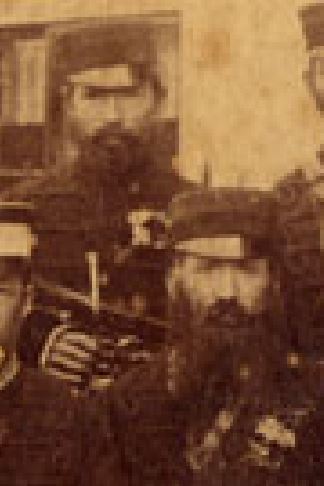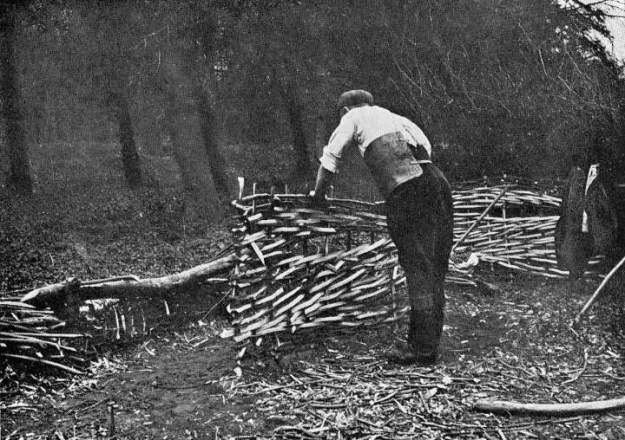At first glance our Sepia Saturday theme this week of Aprons seems a strange choice, but when you start digging you find some remarkable examples. I have decided to go with the men folk.
 A distant relation found this photo in a display in the village hall in Snitterfield. It is the Chatterley family who were wooden hoop and hurdle makers. I believe the man on the right is John Chatterley (1816-1899) which would place this photo in late C19th, His two surviving sons, Thomas Chatterley and William Turner Chatterley were members of the 1887 brass band whose photo I used in A Parting Gift
A distant relation found this photo in a display in the village hall in Snitterfield. It is the Chatterley family who were wooden hoop and hurdle makers. I believe the man on the right is John Chatterley (1816-1899) which would place this photo in late C19th, His two surviving sons, Thomas Chatterley and William Turner Chatterley were members of the 1887 brass band whose photo I used in A Parting Gift
 Here they are in the band photo – William at the back and Thomas to the front. With their full beards they are hard to match to the first photo. Their mother was a cousin of my Tansey grandfather’s grandfather, so there is a distant connection to me through the Hutchins family.
Here they are in the band photo – William at the back and Thomas to the front. With their full beards they are hard to match to the first photo. Their mother was a cousin of my Tansey grandfather’s grandfather, so there is a distant connection to me through the Hutchins family.
The hurdle making is a fascinating process. One of the uses the farmers had for hurdles was for making small enclosures for lambing ewes. In this photo notice the padded leather protector worn at waist level to protect his clothes from being torn when weaving the hurdle. The man seated in the first photo is also wearing one.
 Here is an interesting and instructive video on hurdle making.
Here is an interesting and instructive video on hurdle making.
In John Chatterley’s will he give and bequeath the goodwill of my trade or business of a Hurdle Maker and Hoop Shaver and the stock in trade tool-utensils chattels to his sons William and Thomas , This is the first time I have seen this phrase Hoop Shaver. Wood hoop maker is the term usually applied to the family members whereas a Hoop Shaver: created and fitted metal hoops to barrels, casks and tubs.
One interesting comment I came upon was The main use for (wooden) hoops by the middle of the 19th century would have been for baskets and light tubs: barrels tended to be hooped with iron. Expect to find a thriving baket-making industry where you find hoop makers!
Perhaps the Chatterleys even contributed to the basker making for the lovely ladies of Cranford ! of
There are some things in the photo of which I am not sure, such as what appear to be stacks of hoops.of many sizes or concentric rings. Has anyone any knowledge in this field.
PS He didn’t mention leaving any aprons in his will.
You might also enjoy Men in Aprons – The Potter
And for a range of apron stories visit the links in Sepia Saturday


Pingback: Men in Aprons – The Potter | Bound for Australia
One of the best things about Sepia Saturday is that I learn something new every week. From your header I thought this was going to be a blog about hurdle running races! I never knew those fences were called hurdles. “Carefully managed coppiced hazels” sounds like hard work as well but I suppose the hurdle makers had their regular suppliers rather than growing their own.
LikeLike
I got the impression that he may have had his own supply. There’s a resonable amount of information on coppice management including interesting videos. An eight year cycle after one cutting of a bush until the next cycle. Farmers would have a little coppice in one corner. I just love the way they can split the narrow rod straight down the middle without breaking it.
LikeLike
Two great posts. It was fascinating to watch the hurdle making.
LikeLike
Very interesting. I have never seen that type of “hurdle” before.
LikeLike
Men in aprons – you win! It’s nice to see and read something new (to me): hurdle – making. I find the video especially interesting because I have been looking around for anything about my namesake. Love it!
Hazel
LikeLike
I never thought of the association with the name, even though I have an Aunt Hazel. Perhaps you could get a small hurdle made as a windbreak for your garden then you could call it Hazel’s hazel hurdle !
LikeLike
You’ve picked out a super photo that perfectly fits the theme and illustrates both messy work and practical aprons. A lifetime at such a trade would have developed a specialized knowledge of the properties of timbers and left indelible marks on the worker’s hands.
LikeLike
I just loved watching the part where they split the slender pole straight down the middle without breaking it.
LikeLike
Oddly enough there’s just een BBC TV programme that featured hurdle making – Medieval style – but what a craft it was.
LikeLike
With any luck someone might just put it on YouTube. Then I could have a look. I was also interested to find that it was the basis of building a small shelter, then plug up the gaps with clay.
LikeLike
How refreshing to see men at work in aprons, with that first image particularly striking. . .
LikeLike
I think the butcher is an obvious apron-wearer too, and I also have a photo of an early bootmaker in an apron..
LikeLike
The hurdle is quite a structure but so much better looking than plain ol’ wire fencing.
LikeLike
There are so many interesting job titles from years ago that we have no idea of – thanks for clarifying one of them. I think I have a hoop something in my ancestors, must have a look now.
LikeLike